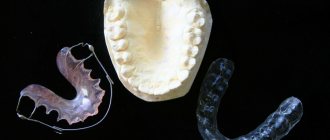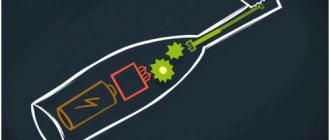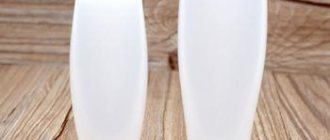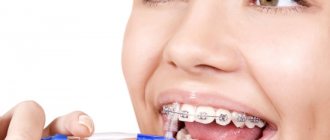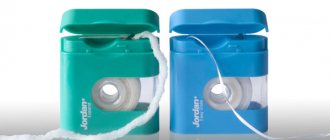Many orthodontists consider childhood to be the most appropriate age for correcting the position of teeth that have erupted and are just beginning to emerge, and for correcting malocclusion. This is due to the fact that the child’s jaw is still developing, so in a short time it is possible to correct existing defects and prevent the situation from getting worse. The most common reason for a child’s malocclusion is the lack of attention to this problem on the part of his mother. It is normal for a child to have a lower jaw that is smaller than the upper jaw, but during natural feeding this defect is usually corrected.
Many orthodontists consider childhood to be the most appropriate age for correcting the position of teeth that have erupted and are just beginning to emerge, and for correcting malocclusion.
The main causes of malocclusion:
- The hole in the nipple is too large (with artificial feeding). The child does not need to make any effort to obtain food and the jaw does not work or develop.
- Lack of roughage in the diet;
- Lack of minerals and vitamins in the body;
- Mouth breathing due to problems with blocked sinuses.
However, all this is not an insurmountable obstacle to getting a child a beautiful smile with straight teeth.
The most common reason for a child’s malocclusion is lack of attention from his mother.
Orthodontic equipment for teeth straightening and bite formation
There are several tools to straighten your teeth and form your bite:
- Trainers;
- Braces;
- Plates for teeth straightening.
Trainers
Most orthodontic devices designed to correct malocclusion eliminate the consequences of the pathological process, without excluding its cause. A dental trainer is a device that performs both tasks. Wearing trainers helps develop the jaw muscles, reduce pressure on the jaw bones, restore breathing through the nose and correct tongue position. Suitable for treating children from 5 years of age. They are especially effective when replacing baby teeth with permanent ones to correct their incorrect position. Wearing time is limited to night and a few hours during the day.
An impression is not required for production. Transparent silicone is used in different colors to make them more interesting for children to wear. Adapts well and does not affect diction. It is used for minor bite deviations, and can even replace braces if there are contraindications to wearing them.
First, trainers with soft silicone are used. Later, more stringent ones are used. Used for: deviations in tooth growth (location, direction, etc.), impaired swallowing function, pathologies of the oral cavity leading to chronic nasal congestion. They require daily care just like all devices.
Braces
Braces are special linings for each tooth, which are strung on a rigid metal arch. The main qualities of the arc:
- Strength;
- Elasticity;
- Availability of shape memory. No matter how the wire is bent during the treatment process, it tends to take its original shape.
Braces are the most common way to correct malocclusions. Starting from the age of 12 (the average period for the final eruption of permanent teeth), they can be installed in children. Braces are a non-removable device. They are attached to each tooth. Wearing them requires regular visits to your doctor, who determines and regulates the tension of the wire. When wearing braces, they are quite noticeable, and this affects the teenager’s behavior (they become more shy, tense and smile less often). The use of braces requires increased attention to oral hygiene (food gets stuck in the system) and imposes restrictions on the consumption of certain foods (hard and viscous). But despite the disadvantages, this is a very strong and durable design that allows you to eliminate many bite defects.
The use of braces requires increased attention to oral hygiene
Retainer
A retainer (in this case, a permanent retainer) is a thin wire made of the same material as the bracket arch. It is not an independent orthodontic device, but serves to prevent aligned teeth from returning to their original place. It is usually installed before removing braces, so we decided to mention it. It is not noticeable to others because it is attached to the inside of the jaw, where it is secured with dental cement that hardens under the influence of ultraviolet radiation. It is almost impossible to tear off, so there are no restrictions on eating hard and sticky foods.
Correct your bite or dental defect with invisible aligners Find out what it is
Device
Before you start adjusting the lock yourself, you need to figure out what the correction device consists of. Standard structure:
- Plastic base that follows the anatomy of the palate and jaws. Solid, durable, but not causing severe discomfort to the child. It comes in different shades, often bright, to appeal to children.
- Wire hooks, which in most cases are attached to the molars.
- Metal arc. It puts pressure on the rows and helps move them in the right direction.
- A screw with a hole located in the center. It is this that is activated and periodically tightened.
- Bright marking arrow indicating the direction for adjusting the device.
Plates for teeth straightening
Orthodontic plates are often called “braces” or “plates on the teeth.” This device is used to treat children under 15 years of age. Made individually for each child. It is attached to the outer surface, the inner part and can partially cover the sky. Made from soft or medium hard plastic and metal. The child takes food without any discomfort. There is no need for any special care for the plates.
Purpose:
- abnormal development of the bones of the jaw arches (narrowness of the jaw bone or disruption of its shape);
- the need to adjust the position of one or more teeth;
- movement of individual teeth;
- the presence of gaps between teeth (three and diastemas);
- the need to correct the narrowing of the palate;
- activation or slowdown of the jaw growth process;
- consolidation of results after using other orthodontic systems;
- preventing crowding;
- prevention of relapses of malocclusion, etc.
There is no need for any special care of the plates
What does an orthodontic screw in plates look like and what is it for?
In general, an orthodontic screw or lock is a factory-made mechanical element that is included in many orthodontic plates. It is usually made from stainless steel.
There are different types of screws, different in size, shape, and purpose - some are used only in structures for the upper jaw (Bertoni, Steiner). Many of them are capable of working in several directions at once: moving individual teeth, symmetrically and asymmetrically expanding, narrowing or lengthening the base of the apparatus in order to influence the dentition.
Screws are made up of several threaded pins and have a thickening in the center called a barrel. There are holes in the drum - through them the plate is activated with a special key, which the orthodontist gives to the patient after installing the device.
Classification of plates for teeth straightening
According to use, the equipment is:
- removable;
- non-removable.
Removable
– the simplest design, and is installed on children from 7 to 15 years old for short-term correction of teeth or bite. Fixed with hooks and worn daily. The duration of wearing is determined by the attending physician. They are most often made of plastic, but sometimes they come in complex designs that include springs and screws. The doctor periodically adjusts the device to obtain gentle pressure on the teeth. This achieves a positive therapeutic effect. The teeth are straightened and the bite is corrected. Such equipment is used when it is not possible to correct the defect using only a plate. Can be installed on both the upper and lower jaw.
Fixed (stationary)
– installed once using fixing brackets that prevent movement when eating, for up to two years. Monitoring and adjustment is carried out by the attending physician during a scheduled visit. It is most often used for young children and to correct serious developmental defects of the jaw apparatus.
Differences:
- stationary is more effective in correcting defects. More expensive than the removable version;
- removable, easy to remove at any time. Easier to care for.
According to the material of manufacture:
- metal;
- plastic.
Metal
– made of titanium-nickel or titanium-molybdenum alloy, which do not oxidize in the aggressive environment of the oral cavity. Outwardly it looks like a combination of wires and hooks. It can be either removable or non-removable. Used to treat children of all ages.
Plastic
– most of these plates are removable and are intended for treating children of middle and older age groups.
By purpose and device:
- Single-jaw – used to restore the dentition when it is shortened or narrowed, as well as to eliminate defects of individual teeth. Consist of a plate with adjustable orthopedic screws. Suitable for children of all ages.
- With retraction arch. Correct protrusion of teeth in a row. Based on the elastic properties of the arc. Suitable for correction on both jaws.
- With a hand-shaped process on an arch. Correct the position of individual teeth. The process puts pressure on the tooth and aligns its position. Can be installed on both the upper and lower jaw.
- With active pusher. Used to straighten the maxillary anterior incisors. The dentition is aligned with spring mechanisms for each uneven tooth.
- The Andresen-Goipl apparatus (activator) is a removable orthodontic device of combined action designed to correct occlusal defects. The activator makes it possible to fix the lower jaw in the required (extended) position, which gives impetus to its development. In this regard, the growth of the upper jaw is inhibited, the bite is disconnected, and the work of the facial and masticatory muscles returns to normal. Placing the inclined plane of the plate along the entire dentition makes it possible to move teeth in three planes - to the side, back and forward. This allows, with some design changes and additions to the activator, to successfully use it to correct not only distal occlusion, but also other deviations of occlusion.
- Bruckle's appliance is a removable device designed to correct deep mesial bite. It is installed only on the lower jaw, and, due to its design features, it has a positive effect on both dentitions.
- Frenkel apparatus - lip pads, brush shields, and other additional elements are installed on a metal frame. The device is attached simultaneously to both jaws and has a functionally targeted action that limits unnecessary muscle force. The use of the device promotes the normal development of the jaws, dental arches and rows. Open, distal and mesial bites are corrected, but the complexity and duration of production, as well as the high cost, do not contribute to its popularity.
The procedure for adjusting and installing the plate is simple and painless. At first, the child feels discomfort from the presence of the equipment in the mouth, but then he gets used to it.
Possible difficulties
During therapy, certain difficulties may arise, such as:
- The key fails or is lost. The part is very small, so it often happens that it gets lost. There's nothing wrong with that. How to tighten a dental plate for teeth if the key is lost? It can easily be replaced with any sharp object, for example, a sewing needle, knitting needle, or unfolded paper clip.
- Breakage of a metal part. This does not happen often, but when it does happen, it is with devices on the lower jaw due to the smaller size of the plastic base. In such a situation, you cannot do without the help of an orthodontist; you need to go to him as soon as possible. If you repair the record incorrectly, you will damage the device. Only a specialist can assess the scale of the problem and advise further course of action. In some cases, it is necessary not to repair, but to completely change the orthodontic structure.
Procedure for making and installing plates for teeth straightening
The selection and production of plates for correcting the bite is carried out only after examination by an orthodontist. The technique is as follows:
- A volumetric image of the jaw bone tissue (OPTG) is taken;
- Impressions of the jaws are taken;
- They are sent to a dental laboratory to produce the selected plate;
After the orthodontic equipment has been manufactured, the doctor installs it and explains to the parents and child how to wear it. The fixed structure takes a little longer to install than the removable one. The procedure for adjusting and installing the plate is simple and painless. At first, the child feels discomfort from the presence of the equipment in the mouth, but then he gets used to it.
How to tighten a screw correctly
As noted above, the teeth straightening plate has an orthodontic screw in the center. How to tighten this screw? The procedure is carried out using a special thin wire key, which is inserted into the screw hole and turned in a given direction - it is indicated by a colored arrow next to the screw, marked on the plate. It is important to understand that all manipulations with the structure are carried out only after you or the child remove it from the mouth.
It is important to know not only about how to properly tighten the plate for the upper and lower teeth, but also about some other nuances:
- the screw can be turned at different speeds,
- one turn occurs when the key is turned all the way: this frees up to 0.25 mm of space,
- to make a new turn, the key must be removed and inserted into the screw hole again,
- the number of revolutions is determined individually based on the clinical situation,
- if you have gone a little overboard, then this should not be scary, because there is always the opportunity to turn the mechanism in the opposite direction.
Important! The key must be removed from the screw hole parallel to the device. This is done with ease, and not with pressure, since otherwise you can return the system to its original position.
“At the appointment, the doctor explained everything to us in detail about how to tighten the plate for the teeth. My son had it installed on his upper jaw. Everything turned quickly. True, I didn’t trust my son with this task; I always did it myself, which in principle is not difficult. There was a case when we were leaving for the dacha and forgot the key at home, so we had to use improvised means to activate it. A paperclip arrived. Of course, I don’t recommend doing this on an ongoing basis, otherwise the device will break, but temporarily it can help someone out...”
Alina Karimovna T., review from gidpozubam.ru
The first activation is carried out by an orthodontist. Responsibility for subsequent twisting falls on the child or his parents. Every 1-2 months you should also bring your child to the doctor to monitor the progress of treatment.
Indications and contraindications for installing braces
The appointment and selection of the correct design is recommended by the doctor.
Treatment is prescribed in the following cases:
- Incorrect position of one or more teeth;
- Jaw bone development problem;
- Narrowing of the palate;
- Malocclusion;
- Teeth displacement after braces;
- Rare arrangement of teeth.
Orthodontists recommend installing plates for children under 12 years of age.
Often plates are placed on braces after treatment to secure the result as a retainer. You shouldn't be afraid of this.
In this age:
- the body grows and corrections occur quickly;
- children at this age are not so painfully worried about the installation of plates;
- children are more obedient and will not remove the plates often.
Plates are not installed in the following cases:
- untreated caries;
- gum disease;
- allergy to plate material;
- respiratory tract diseases;
- presence of stomatitis that requires treatment;
- abnormalities have been identified that require other treatment methods.
Number and time of revolutions
The adjustment is designed specifically to ensure that the gums, jaws and teeth move apart not at once, but gradually. At the very beginning of treatment, this process has not yet started, so no visible result can be expected. How much you need to twist the mechanism is determined solely by the orthodontist.
In the first stages you will only need a few turns. If you do this abruptly, the little patient will experience pain and other discomfort. In addition, the risk of complications, including injury, increases significantly. Therapy will not be accelerated if more revolutions are allowed than necessary in a certain period.
Usually, at the very beginning, twisting is not needed. This is due to the fact that the child is just beginning to adapt to the plate, and unnecessary pain will only worsen the adaptation.
After the adaptation period, expansion can be performed. When the first results become visible, the device is gradually tucked in more and more. As a rule, it is necessary to tighten the arches after 2-3 weeks.
The clinic will draw up a correction schedule, which it is recommended to adhere to. At each appointment, the effectiveness of treatment is assessed, and the regimen may be slightly modified.
In difficult cases, the doctor takes over the function of pulling only himself. This is indicated if the dentition changes unevenly.
Towards the end of the therapeutic course, the intervals increase, this helps to better consolidate the result. At the last stage, there is no need to twist the plate, this will make the bone structures stronger and more stable.
How long should you wear braces?
At the time of active formation of the dentition, the plates are changed approximately every six months. The duration of treatment is determined individually. Usually the defect is corrected in a year to a year and a half, further time is required to consolidate the result. Often plates are placed on braces after treatment to secure the result as a retainer. You shouldn't be afraid of this.
Caring for teeth straightening plates
In order for the equipment to work as expected, you need to perform simple operations. For this it is recommended:
- Clean the plate with a soft toothbrush;
- Use special cleaning gels (daily and weekly);
- Do not engage in active sports with the plate on;
- Store the equipment in a special container;
- Do not try to repair the plate yourself if you discover damage or deformation. You should consult your doctor;
- Treat the structure with a disinfectant solution. If the plate is removable, it is better to place it in the solution overnight;
- Remove the removable plates when eating;
- Before installation, rinse with warm boiled water;
- If the equipment design has a screw, it is recommended to lubricate it with vegetable oil so that it does not stagnate;
- Parents should ensure that the child does not remove the equipment at night;
- Teach your child how to tighten a screw in a plate;
- To avoid complications, periodically visit an orthodontist and follow his instructions;
- Carefully monitor oral hygiene during treatment (the presence of plates increases plaque in the mouth);
- If plaque or tartar is found on the plate, you should consult a doctor for cleaning.
The treatment is helped by a special massage that affects the gums and palate. By improving blood circulation, massage accelerates the healing and growth processes in the jaw area. This massage is performed while brushing your teeth.
When the plate is activated
Parents should not worry about how to tighten the structure. The doctor will show you how to do this at the first and subsequent appointments.
The initial activation is not performed immediately after fixation of the device, but after 1-2 weeks, so that the small patient gets used to his new condition and the constant presence of arches in the mouth.
How often teeth plates are tightened depends on the individual schedule. After the initial activation, you need to do this quite rarely, approximately every 3 weeks (sometimes at intervals of a month), so that the load on children's jaws increases gradually. Then the arches are adjusted much more often (every 7-15 days). When therapy is nearing completion, manipulations are carried out every 3-5 days.
The device is activated by unwinding the drum located in the orthodontic screw placed on the plate. You must use a special key for this. It is issued at an appointment with the orthodontist.
What is better - braces or braces?
The plates are only effective for people under 15 years of age and may not help in some situations. And even at the age of 10-12 years, in some cases it is necessary to install braces. If the pathologies are minor and are in the initial stage, then it is enough to use plates.
Advantages:
- Possibility to remove if necessary;
- Easy to care for your oral cavity;
- Cheaper than braces.
Flaws:
- Often not effective enough;
- Long-term addiction.
Advantages of braces:
- Continuous action on teeth;
- Quick addiction;
- A larger number of defects can be eliminated simultaneously.
Flaws:
- Difficulties in caring for the oral cavity;
- High cost for the entire range of services.
Record prices
The leveling plate costs 2-3 times less than the bracket system. The price of the device is influenced by several factors:
- material;
- additional details;
- plastic coloring.
For example, a plate with one screw costs on average 9-10 thousand rubles. Moreover, each additional screw will increase the price of the device by 1-2 thousand rubles. A special tongue flap will make the plate 1-1.5 thousand rubles more expensive.
Reviews of plates for teeth straightening
Looking through the reviews from parents, it can be noted that they are all positive. Children quickly get used to wearing the equipment. All dental defects are corrected quickly. It cannot be said that for all children the operation with the installation of plates is completely painless, but if everything is chosen correctly, the inconvenience quickly passes.
Dentists also respond well to the plates. Some believe that in adults, correcting defects with plates is even more convenient. For them, this is done even longer, once, but in children, as the jaw grows, the correction plates need to be changed.
Features of getting used to structures
Immediately after installing the plates, many patients feel slight discomfort, which, depending on individual characteristics, goes away after 30 minutes for some, and persists for several days or even weeks for others.
During the adaptation period, the child may feel pressure on the teeth, minor pain, friction and irritation in the soft tissue area where the plastic part of the device fits tightly. Diction may also be slightly impaired, a lisp may appear, salivation may increase, and difficulty swallowing saliva may arise.
Expert opinion
Vagapov on How and when to tighten a dental plate
Specializations:
Experience: 2021+
“After the first and subsequent activations of the orthodontic screw, discomfort may occur again, but it is less prolonged and not as pronounced as after installation of the system - most patients stop experiencing discomfort after 5-10 minutes.”
Summing up
Children's teeth are not only a cheerful smile. It is also an important link in the digestive tract. Depending on the quality of chewing food, the further process of digestion also depends. Disease of the teeth and gums often leads to inflammation of other organs. It is necessary to monitor the condition of a child’s teeth from a very early age. Replacing baby teeth with permanent ones should be natural. Often, an extracted baby tooth causes the molar to erupt in the wrong place, and as a result, the need for orthodontic treatment with plates or braces. Doctors say: “It is better to prevent a disease than to treat it.”
The appearance of malocclusion or crooked teeth must be corrected as early as possible. To identify abnormalities in a timely manner, it is recommended to bring your child for examination to the dentist at least twice a year, starting from the age of one.
Parents should ensure that their child learns to brush his teeth well as early as possible and help him do it correctly.
Periodically examine his oral cavity and if you notice a brown or white spot on his teeth, immediately contact a dentist. Currently, doctors have completely painless ways to treat caries.
Useful tips
As we have already said, the child will have to get used to the plate for some time. In the first 1-2 days, the baby may feel pain and discomfort, his speech may be impaired, and salivation may increase. And, of course, the child will want to remove the record and begin to act up.
Typically, all adaptation symptoms subside 3-7 days after installation and the child ceases to notice the device in the mouth.
It is important for parents to ensure that the child does not try to remove the foreign device from the mouth. Try to distract your child from unpleasant sensations - play, go for a walk, watch an interesting colorful cartoon together. A few days will “fly by” unnoticed and the child will get used to his new smile assistant.
After installing the plate, special attention should be paid to caring for the baby’s oral cavity. Be sure to brush your teeth twice a day (remove the plate during this period) and thoroughly clean the structure itself.
We hope that very soon your child will show off with a luxurious, even smile. And so that children are happy to brush their teeth and enjoy each such procedure, choose for them a pleasant and effective toothpaste, such as Asepta Kids, a gel paste for children from 4 to 8 years old. This reliable product for daily protection against caries is designed taking into account the structural features of children's enamel.
Fluoride-free gel paste carefully protects teeth from caries, cares for baby’s gums, and prevents the development of inflammation in the oral cavity. The product does not contain fluoride, parabens, sodium lauryl sulfate or antiseptics, and the bright taste of “tutti-fruit” will make brushing your teeth very pleasant for your child.
Sources:
- Study of the clinical effectiveness of the use of therapeutic and prophylactic agents of the ASEPTA series in the treatment of inflammatory periodontal diseases in children and adolescents (I.V. Klimova) Irina Vladimirovna Klimova, Candidate of Medical Sciences, Associate Professor of the Department of Pediatric Dentistry, Novosibirsk State Medical University. Department of Pediatric Dentistry, Novosibirsk State Medical University.
- The use of drugs from the Asepta line in the complex treatment of inflammatory periodontal diseases (N.V. Berezina E.N. Silantyeva S.M. Krivonos, Kazan State Medical Academy. Kazan.) N.V. BEREZINA, E.N. SILANTIEVA, S.M. KRIVONOS Kazan State Medical Academy
- Clinical experience in using the Asepta series of products Fuchs Elena Ivanovna Assistant of the Department of Therapeutic and Pediatric Dentistry State Budgetary Educational Institution of Higher Professional Education Ryazan State Medical University named after Academician I.P. Pavlova of the Ministry of Health and Social Development of the Russian Federation (GBOU VPO RyazSMU Ministry of Health and Social Development of Russia)
Correction of mesial bite
People with this defect tend to have a protruding chin. If the flaw is inherent in a man, then the aesthetics may not be disturbed, since the face takes on a strong-willed and decisive expression. When a girl is susceptible to the defect, bite correction is required immediately. The consequences are as varied as with distal closure of teeth. This is the risk of early onset of periodontal diseases, the development of caries, and the complexity of prosthetics.
Mesial correction of occlusion in adults is a lengthy process. The sooner orthodontic treatment is carried out, the sooner the result is achieved. The ideal time for this is considered to be childhood, when the development of the jaw apparatus is not yet complete. In this case, different removable structures are used. In adults, dental braces, possible removal of some row elements, and orthognathic operations are most often used.
Space holder for children's bite: types and designs
Pediatric orthodontists at Aza&Buka dentistry select a tooth space holder based on the specific clinical situation. Main options:
Replacement plate - a plate with artificial teeth to replace missing milk units. Completely restores the functions of the jaw row, maintains the bite, and helps the permanent units to erupt in a timely manner due to the correct pressure on the bone tissue. Replacement plates are adjusted to suit the child’s changing bite - as the jaw grows, until the appearance of missing permanent teeth. The product is removable and is attached with metal or plastic hooks to adjacent teeth.- A two-jaw removable functional appliance is a design for solving several orthodontic problems. Artificial teeth replace the removed units, and the relative position of the dental arches is responsible for the harmonious overlap of the lower teeth with the upper ones.
- A place retainer is a non-removable orthodontic product. A rigid metal ring fences off the area where the permanent tooth will erupt and prevents the mobility of neighboring units. Once the molar begins to grow, the holder is removed, allowing the permanent unit to take its place. The design is excellent for replacing a first or second molar. It is placed mainly in “invisible” zones.
Benefits of dental plates
Dental plates, like every orthodontic design, have a number of advantages.
· Fast production.
Typically, no more than a week passes from the moment the impression is taken to the first installation.
· Safety.
The plates are made of hypoallergenic high-quality material.
· Easy care.
It just involves regular cleaning.
· Affordable price.
Dental plates are a budget option for correcting malocclusion and other dental anomalies.
The disadvantages of this design include only a longer treatment period compared to the use of braces.
How plates are made and put on
The treatment process begins according to the following algorithm:
- The orthodontist makes impressions of one or both jaws.
- X-ray control is carried out.
- A fitting of the preliminary plaster version is scheduled.
- A permanent plate model is made.
It is important that the plastic frame fully displays the relief pattern of the dentition. The metal parts are designed to provide the most reliable fixation.
When the plates are installed on the patient, he does not experience pain. The only difficulty at first may be related to speech, to clearly pronouncing individual sounds. Also at first there is likely to be increased salivation. However, this should pass in just a couple of days.
Appearance of the record
Any plate consists of a relatively rigid base, which exactly follows the relief of the hard palate, and a metal wire arch that fixes the teeth in a certain position. Some types of plates are additionally equipped with clasps, screws or springs.
Such structures are made from high-quality hypoallergenic materials without harmful chemical impurities. The base of the plate is plastic, and the hooks - clasps, arches and the correction mechanism are made of a nickel-titanium alloy, which is durable and lightweight. Therefore, parents do not need to worry that their child carries the record in his mouth all day long.
How is the appointment going?
Plates with artificial teeth for children are produced in several stages:
- Examination by a pediatric orthodontist
The doctor will evaluate the condition of the teeth, the characteristics of the bite, and the prospects for the eruption of the molars. He will refer you for a detailed examination - x-ray, optg.
- Preparing the child's mouth
Before the manufacture and installation of an orthodontic holder, the baby’s teeth will be treated and impressions will be taken to prepare a replacement structure.
- Making and installing a record
When fixing the product in the oral cavity, doctors focus on the convenience and comfort of the young patient. The seat retainer should not rub the gums or interfere with speech or eating.
- Care training and questions answered
An orthodontic replacement plate requires systematic cleaning, which the doctor will tell the child and his parents about. The specialist will also answer all questions about the duration and importance of treatment.
Space retainer after milk tooth extraction: indications for installation
A replacement structure is placed when temporary teeth are removed prematurely. Doctors call premature loss of milk units more than 1 year before the period of physiological change of teeth. In this case, it is necessary to prevent the displacement of the remaining units and maintain the correct shape of the dentition.
Also, plates are placed on baby teeth with fixation of the place under the molars in the following cases:
- Adentia is a partial or complete absence of teeth due to abnormalities in the development of the child’s dental system.
- Tooth impaction is the failure of a tooth to erupt properly due to malposition or other reasons.
- Early removal of teeth - permanent or temporary, which leads to the displacement of neighboring units towards the empty space.
- Defects of the upper dentition - caused by congenital cleft of the upper lip.
There are no contraindications for the installation of an orthodontic placeholder. Special cases are resolved directly with the children's doctors at the Aza&Buka dental center.
